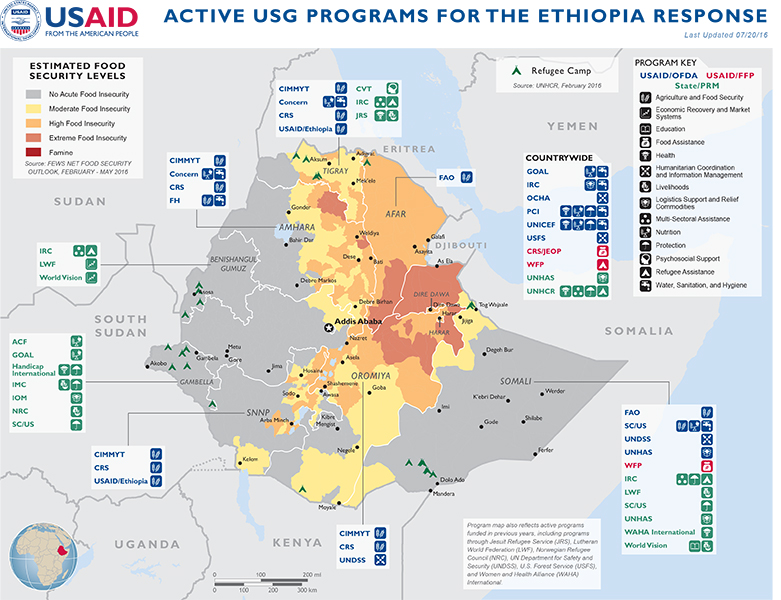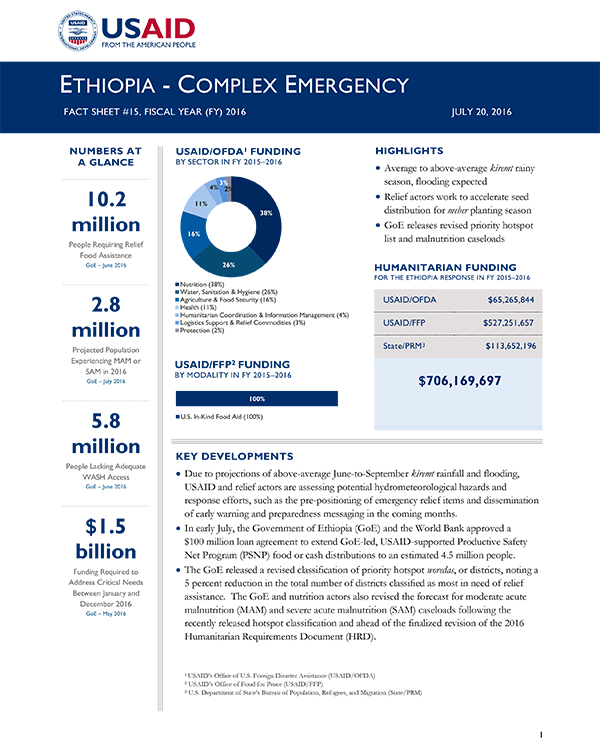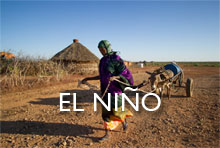- What We Do
- Agriculture and Food Security
- Democracy, Human Rights and Governance
- Economic Growth and Trade
- Education
- Ending Extreme Poverty
- Environment and Global Climate Change
- Gender Equality and Women's Empowerment
- Global Health
- Water and Sanitation
- Working in Crises and Conflict
- Disaster Assistance
- Political Transition Initiatives
- Conflict Mitigation and Prevention
- Countering Violent Extremism
- Disaster Risk Reduction
- Peacebuilding and Reconciliation
- Providing Safe & Secure Environments for Development
- Recovering From Crisis
- Resilience
- Tech Challenge for Atrocity Prevention
- World Humanitarian Day
- U.S. Global Development Lab
July 20, 2016
Highlights
Average to above-average kiremt rainy season, flooding expected
Relief actors work to accelerate seed distribution for meher planting season
GoE releases revised priority hotspot list and malnutrition caseloads
Key Developments
Ethiopia Map - 07-20-2016 ![]() (pdf - 783k)
(pdf - 783k)
Numbers At A Glance
10.2 million
2.8 million
5.8 million
$1.5 billion
Humanitarian Funding
For the Ethiopia Response
FY 2015 - 2016
| USAID/OFDA | $65,265,844 |
| USAID/FFP | $527,251,657 |
| State/PRM | $113,652,196 |
| TOTAL | $706,169,697 |
Due to projections of above-average June-to-September kiremt rainfall and flooding, USAID and relief actors are assessing potential hydrometeorological hazards and response efforts, such as the pre-positioning of emergency relief items and dissemination of early warning and preparedness messaging in the coming months.
In early July, the Government of Ethiopia (GoE) and the World Bank approved a $100 million loan agreement to extend GoE-led, USAID-supported Productive Safety Net Program (PSNP) food or cash distributions to an estimated 4.5 million people.
The GoE released a revised classification of priority hotspot woredas, or districts, noting a 5 percent reduction in the total number of districts classified as most in need of relief assistance. The GoE and nutrition actors also revised the forecast for moderate acute malnutrition (MAM) and severe acute malnutrition (SAM) caseloads following the recently released hotspot classification and ahead of the finalized revision of the 2016 Humanitarian Requirements Document (HRD).
CURRENT EVENTS
From July to September, available forecasts from the U.S. National Oceanic and Atmospheric Administration, the GoE Meteorology Agency, and other sources suggest that above-average rainfall and associated flooding could affect areas of central Ethiopia, potentially exacerbating humanitarian needs. The probable development of a mild-to-moderate La Niña climatic event could further contribute to the likelihood of above-normal rainfall. Kiremt rainfall commenced up to two weeks earlier than the typical start date in several areas of Ethiopia, with average rainfall distribution to date, according to the USAID-funded Famine Early Warning Systems Network (FEWS NET). Kiremt rains are expected to remain average to above-average countrywide, and flooding is likely to affect at-risk areas in July and August; areas of northern and northwestern Ethiopia have already experienced excessive rainfall and harsh weather conditions, including hail storms.
The multi-agency GoE-led Flood Task Force estimates that flooding had affected up to 690,000 people across Ethiopia, including in Afar, Amhara, Oromiya, Somali, Tigray, and Southern Nations, Nationalities, and Peoples (SNNP) regions, as of June—a 42 percent increase from the task force’s projection of 485,000 flood-affected people as of May. Additionally, floods have resulted in livestock deaths and destroyed approximately 55,000 hectares of land countrywide in 2016 to date, according to USAID/OFDA partner the UN Food and Agriculture Organization (FAO). In the coming months, expected flood-related humanitarian needs include emergency relief commodities, agriculture assistance, and livestock health services and feed. USAID and relief actors are assessing potential hydrometeorological hazards in flood-prone areas and response efforts, such as the pre-positioning of emergency relief items and dissemination of early warning and preparedness messaging in the coming months.
FEWS NET forecasts that populations residing in drought-affected areas—including Amhara’s Wag Himra Zone, Oromiya’s East Hararghe and West Hararghe zones, and pastoral areas of Afar and Somali—will continue to face Crisis—IPC 3—levels of food insecurity through the conclusion of the lean season in September.4 FEWS NET expects that an average meher harvest and livestock productivity improvements will increase access to food and income-generating opportunities, reducing the number of people requiring relief food assistance beginning in October.
Due to average February-to-June belg rainfall, moderate pasture regeneration, and ongoing humanitarian assistance, the GoE approved a revised list of districts classified as priority hotspots on July 11. Since the March classification exercise, the total number of hotspot districts decreased by 23 to 420 districts, representing a 5 percent decrease in the total number of hotspots; the number of priority one districts also decreased by 5 percent to 206 districts. Despite the slight decrease since March, the July hotspot classification list still represents an approximately 415 percent increase in priority one hotspot districts and more than 24 percent increase in total priority hotspot areas since February 2015. Hotspot classifications—conducted by the GoE National Disaster Risk Management Commission (NDRMC), the Emergency Nutrition Coordination Unit (ENCU), FEWS NET, the UN Children’s Fund (UNICEF), and the UN World Food Program (WFP)—are based on assessments of multiple indicators, including access to markets, agriculture, food security, health, livelihoods, nutrition, and water, sanitation, and hygiene (WASH) conditions. The list typically guides nutrition and other humanitarian stakeholders to prioritize resource allocation and target response interventions for vulnerable populations in areas most-affected by drought.
Intercommunal clashes along the border between Oromiya and Somali displaced approximately 56,600 people in June, according to the International Organization for Migration (IOM). More than 50,700 of the June internally displaced persons (IDPs) fled from areas of Oromiya’s East Hararghe, Guji, and Jimma zones, and an additional 5,890 people fled Somali’s Liben Zone. An estimated 82 percent of the 298,400 people, or nearly 54,200 households, displaced by floods between March and June have returned to areas of origin, according to IOM.
UN Special Envoy for El Niño and Climate Change Mary Robinson met with representatives from the GoE and visited non-governmental organization (NGO)-supported nutrition treatment centers and seed distribution points in Tigray from July 5–6. During a meeting with Mitiku Kassa, head of the NDRMC, Special Envoy Robinson commended GoE leadership in the early stages of the drought response and recommended documenting lessons learned during the current response to prepare for future climatic shocks, according to the UN.
FOOD SECURITY
In early July, the GoE and the World Bank signed a loan agreement for approximately $100 million to support an extension of the PSNP. PSNP food and cash transfers were scheduled to conclude in July prior to the extension, potentially leaving an estimated 4.5 million PSNP beneficiaries without assistance to meet their critical food needs. The new loan will allow for an extension of the PSNP to continue providing relief assistance to 4.5 million people, likely affecting the number of people in need of relief food assistance in the revised 2016 HRD, expected for release in July. The World Bank has supported the GoE to alleviate chronic food insecurity since the launch of the PSNP in 2005.
As of July 15, the GoE and relief actors—including WFP and the USAID-supported, Catholic Relief Services (CRS)-led Joint Emergency Operation (JEOP)—had dispatched approximately 92 percent and distributed 74 percent of the in-kind food supplies intended for the fourth round of relief food assistance, which began in early May, according to WFP. Delivery and distribution of the fourth and fifth rounds of relief food assistance are concurrently ongoing, with 43 percent of the fifth round dispatched and 8 percent distributed as of July 15. To date, the GoE and relief actors have only begun fifth-round relief food distributions in Somali and Tigray. WFP expects the allocation and dispatch of relief food supplies for the sixth round to commence by late July.
AGRICULTURE
Emergency seed interventions are ongoing across meher-producing areas of Ethiopia, including in Afar, Amhara, Oromiya, SNNP, Somali, and Tigray, as farmers continue land preparation and planting activities. As of July 12, relief organizations—including FAO and NGOs—had procured at least 75 percent and distributed 63 percent of approximately 26,600 metric tons (MT) of critical seed supplies planned for beneficiary farmers across the six regions during the meher season. USAID emergency seed partners—including CRS, the International Maize and Wheat Improvement Center (CIMMYT), Food for the Hungry (FH), the International Potato Center, and the Relief Society of Tigray (REST)—are contributing more than 40 percent, approximately 10,600 MT, of the total seed response planned for drought-affected households in Amhara, Oromiya, SNNP, and Tigray. The USAID-supported partners had procured approximately 88 percent and distributed 63 percent of the planned seed supplies to intended beneficiary households as of July 12.
The GoE, international donors, and relief organizations have expressed concern regarding the quickly approaching end of the planting period for most crop varieties in mid-to-late July. Planting conditions may be optimal in certain areas of the country through August based on seed varieties and micro-climates. CRS and other relief agencies are deploying in-country staff and identifying solutions to effectively mitigate key impediments to timely seed distribution, including coordination with sub-grantees, delayed reporting of field activities, limited availability of some seed supplies, and local GoE requirements. FAO, which co-leads the Emergency Seed Working Group, convened all partners conducting emergency seed interventions on July 18 to assess the progress of seed procurement and distribution as the optimal planting period advances.
NUTRITION
The GoE and nutrition actors have revised the forecast for MAM and SAM caseloads following the newly released hotspot classification and ahead of the finalized revision of the 2016 HRD. The ENCU reports that approximately 420,000 children younger than five years of age will likely experience SAM countrywide and approximately 2.36 million people—including an estimated 1.5 million children and 836,000 pregnant and lactating women in priority one districts—will be targeted for MAM treatment between January and December. The revised MAM and SAM caseloads represent a 6 percent and 8 percent decrease, respectively, from the early 2016 projections of 2.5 million MAM cases and 458,000 SAM cases for the year. Lower-than-expected January-to-May acute malnutrition treatment and therapeutic feeding program admissions largely account for the reduced caseload, although nutrition-related needs are expected to remain higher in 2016 than in typical years, according to the ENCU. UNICEF typically prepares for an estimated 250,000 SAM cases in Ethiopia. NGOs are currently implementing emergency nutrition activities in 47 percent of the 206 newly classified priority one hotspot districts and WFP plans to reach all priority one districts with ready-to-use supplementary food or SuperCereal+ to support the treatment of children and women experiencing MAM. Additionally, the NDRMC plans to provide corn-soy blend and cooking oil rations to support targeted supplementary feeding for MAM cases in all priority two hotspot districts for a six-month period.
LOGISTICS
A special operation implemented by WFP and members of the Logistics Cluster—the coordinating body for humanitarian logistics activities, comprising UN agencies, NGOs, and other stakeholders—aims to improve delivery and distribution of urgently needed food supplies and increase storage capacity at NDRMC hubs and regional- and local-level warehouses. As of July 7, cluster members had established mobile storage units and acquired warehouse space to increase GoE storage capacity by approximately 19,600 MT—the equivalent of nearly two full warehouses—at the Adama hub in Oromiya. In Afar, Gambella, and Oromiya regions, cluster members have increased local storage capacity by an estimated 7,200 MT. Site assessments to construct additional mobile storage units are ongoing, with nearly 50 assessments completed and a total of 120 units planned in the special operation.
CONTEXT
Multiple consecutive seasons of below-normal rainfall and the current effects of the El Niño climatic event have resulted in deteriorating agricultural, livestock, food security, and nutrition conditions in northeastern and central Ethiopia. By December 2015, the GoE estimated that 10.2 million people required relief food assistance and other humanitarian interventions during 2016.
USAID activated a DART on February 24, 2016, to lead the USG crisis response to the drought in Ethiopia. In support of the GoE, the DART is coordinating USG response activities in close partnership with the UN and other relief organizations. The DART—composed of humanitarian specialists based in Ethiopia—is addressing critical needs and examining ways to realign activities to respond to urgent assistance gaps. USAID also established an Ethiopia Drought Response Management Team (RMT) based in Washington, D.C., to support emergency response efforts in Ethiopia.
While drought remains a major contributor to vulnerability in Ethiopia, negatively affecting the lives and livelihoods of farmers and pastoralists, populations also continue to confront other challenges—including seasonal flooding, localized intercommunal conflict, above-average food prices, disease outbreaks, and limited access to health and WASH services—that contribute to sustained humanitarian needs and an ongoing complex emergency in Ethiopia.
On October 7, 2015, U.S. Chargé d’Affaires, a.i., Peter H. Vrooman re-declared a disaster for Ethiopia in response to the ongoing complex emergency.
PUBLIC DONATION INFORMATION
The most effective way people can assist relief efforts is by making cash contributions to humanitarian organizations that are conducting relief operations. A list of humanitarian organizations that are accepting cash donations for disaster responses around the world can be found at www.interaction.org.
USAID encourages cash donations because they allow aid professionals to procure the exact items needed (often in the affected region); reduce the burden on scarce resources (such as transportation routes, staff time, and warehouse space); can be transferred very quickly and without transportation costs; support the economy of the disaster-stricken region; and ensure culturally, dietary, and environmentally appropriate assistance.
More information can be found at:
- USAID Center for International Disaster Information: www.cidi.org or +1.202.821.1999.
- Information on relief activities of the humanitarian community can be found at www.reliefweb.int.










Comment
Make a general inquiry or suggest an improvement.